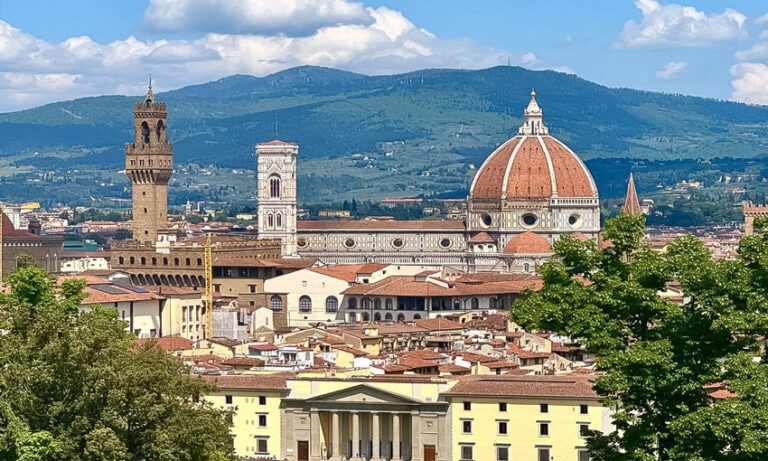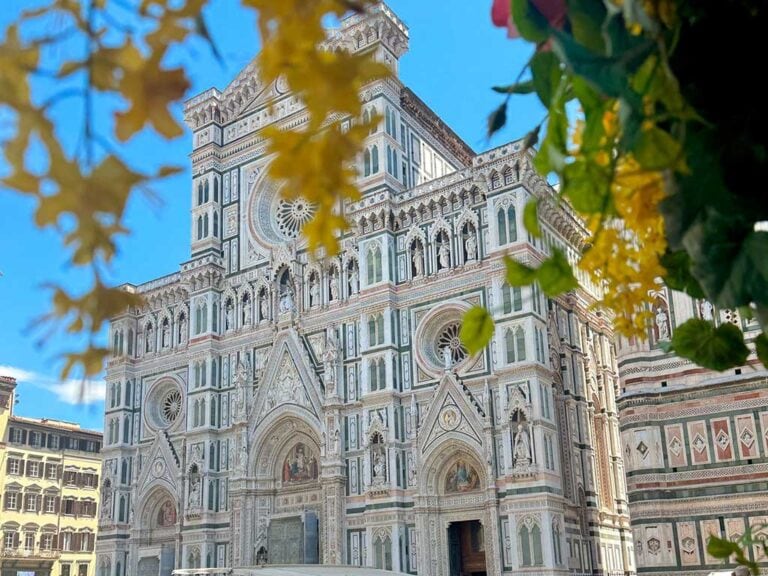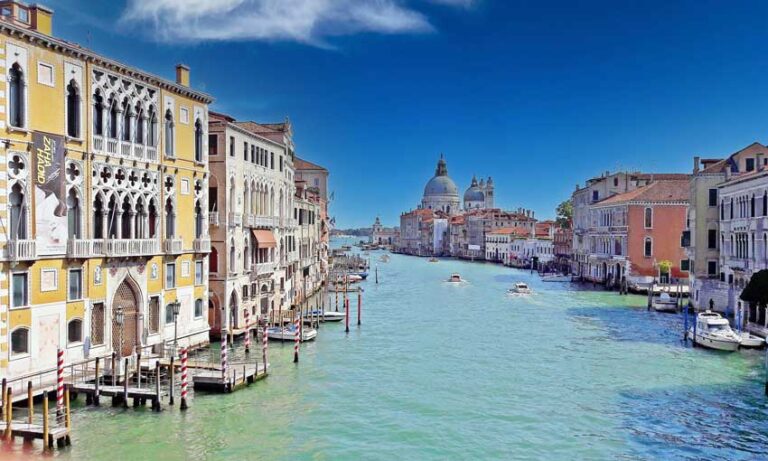Sperlonga feels like a corner of Greece in Italy. White houses line the hill, fishing boats rest in the port, and the beaches seem endless. Add Roman ruins and fresh seafood, and you’ve got one of Lazio’s best coastal getaways.


Where is Sperlonga and how to get there
Sperlonga lies halfway between Rome and Naples: 128 km from Rome and 110 km from Naples.
From Rome, you can drive along the Pontina road (SS148) to Terracina, then continue on the coastal Flacca road, or take the A1 motorway and exit at Frosinone before heading down to the coast. From Naples, the easiest route is the A1 with an exit at Cassino, then continue to Formia and along the Flacca. Both trips take about two hours, but in summer weekends traffic jams are common, especially near Terracina and Gaeta.
By train, the nearest station is Fondi–Sperlonga, on the Rome–Naples line. It’s 10 km from the town, with buses (COTRAL) and private shuttles taking about 20–25 minutes to reach Sperlonga.
The closest airports are Rome Fiumicino, Ciampino, and Naples Capodichino, all around 130–150 km away.
Keep in mind: the old town is pedestrian-only and has a ZTL (limited traffic zone).

The History of Sperlonga: From Tiberius’s Villa to a Hilltop Village
The name Sperlonga comes from the coastal caves, or speluncae. In one of these caves — today called the Cave of Tiberius — the Roman emperor built the dining room of his seaside villa. It was once decorated with huge marble statues of scenes from Homer’s Odyssey, now displayed in the local archaeological museum.
After the fall of Rome, the coast was often attacked by pirates. To protect themselves, the people moved uphill and built a fortified town with narrow lanes, compact houses, and watchtowers. In 1534, the Ottoman admiral Barbarossa raided the village, but Sperlonga later recovered and slowly became the town you see today.

The old town
The old town of Sperlonga is a maze of white alleys, arches, and stairways. The walls weren’t painted white just to look pretty — the bright color reflected the sunlight and made it harder for pirates to sneak in.
You can enter the old town from two main gates. Porta Marina takes you toward the beach, while La Portella brings you into the central lanes. Here you’ll find the Church of San Leone Magno, dedicated to Sperlonga’s patron saint. Piazza Europa is home to the modern Church of Santa Maria Assunta, while the older Church of Santa Maria di Sperlonga is no longer used for worship.
As you wander, you’ll also come across little squares like Piazzetta del Pozzetto and Piazzetta della Concordia, which in summer turn into lively spots for concerts and events.
Things to See in Sperlonga: Torre Truglia, Villa of Tiberius, and More
One of the town’s main landmarks is Torre Truglia, a coastal watchtower built in 1532 on a rocky spur at the edge of the port. Over the centuries it was destroyed and rebuilt several times, first used to defend against pirates and today used for cultural events. From the top, you get some of the best panoramic views of Sperlonga.
Just outside the town are the ruins of the Villa of Tiberius. Here you can see remains of the emperor’s residence, ancient fish tanks, and the famous grotto. Ancient writers tell how part of the cave once collapsed during a banquet, nearly killing Tiberius. Today, the site is part of the National Archaeological Museum, where you can see the marble sculptures found here. The most famous are the dramatic scenes from Homer’s Odyssey, including Odysseus blinding the Cyclops Polyphemus and Scylla attacking a ship.
Along the coast you’ll also spot other watchtowers, while inside the town you can visit the Spiaggia della Sorgente, a beach where fresh water still flows directly into the sea.
Top Beaches in Sperlonga, Italy
Sperlonga’s beaches are long, sandy, and all Blue Flag certified.
On the western side is the Spiaggia di Ponente, stretching for kilometers toward Terracina. It’s divided into sections known as Fontana, Canzatora, Salette, and Bonifica. This is the busiest area, with beach clubs and some free zones.
To the east are the Spiaggia dell’Angolo, close to the old town and the Villa of Tiberius, and the quieter Spiaggia di Bazzano, surrounded by greenery. A bit further is the Spiaggia delle Bambole, a smaller cove with white pebbles, reachable by boat or hiking path.
Sperlonga Travel Tips: Parking, Beaches, and Accessibility
Parking is one of the biggest challenges in Sperlonga, especially in summer. Most parking lots are paid and fill up quickly. Prices are around €3 per hour, €20 for a full day, €50 for three days, and about €100 for a week. There’s a lot near the town center and others just outside. After 5 PM it’s almost impossible to find a spot close to the center, so plan ahead. A shuttle bus also connects the main parking areas with the old town.
Most beaches are private and equipped. Expect to pay about €25–30 per day for an umbrella and two sunbeds. Free beach sections exist too, and they’re well maintained. Many beach clubs also offer accessibility with ramps, special chairs, and facilities for visitors with disabilities.
The old town, however, is full of steps and uneven alleys, which can be tricky with strollers or wheelchairs.
What to Eat in Sperlonga: Local Food and Dishes
Sperlonga’s cuisine mixes seafood with produce from the surrounding land. A classic is the fish soup Sperlongana-style, often served with bread, along with simple dishes like spaghetti with clams or telline (tiny clams). Another local specialty are bambolotti pasta with cuttlefish sauce.
The most unique product is the White Celery of Sperlonga (IGP), grown in sandy soils and usually eaten raw with olive oil. Local olives from nearby Gaeta and the traditional tiella, a stuffed pie with octopus or vegetables, are also common.
Recommended restaurants include Il Porticciolo, Da Martini sul Ponte, and La Ricciola Saracena. For a more casual option, MarVino is a wine bar with seafood plates and aperitifs.
Every summer Sperlonga hosts food and cultural events. In June, Sapori di Mare is dedicated to local fish and produce. The Torre Truglia often serves as a venue for markets, concerts, and exhibitions.
The patron saints San Leone and San Rocco are celebrated in early September with religious processions and fireworks over the sea. In summer you’ll also find outdoor cinema and evening shows, while Christmas brings nativity scenes and lights in the old town.

What to Buy in Sperlonga: Shopping, Souvenirs & Local Crafts
You won’t find big malls or designer brands here (those belong to Rome or Naples). Instead, the charm lies in the small things: a leather shop tucked beside a bar, a straw kiosk where the owner weaves bags by hand, or a market stall selling olives that taste of the sea.
Interesting Facts About Sperlonga
On the Fontana beach there’s a natural freshwater spring that once supplied the town with drinking water. The underground flow causes a “quicksand” effect where your feet slowly sink.
Local legends tie Sperlonga to Homer’s Odyssey, while history recalls pirate raids and Ottoman attacks. The town still remembers the 16th-century sack by Barbarossa.
In recent years, loggerhead turtles (Caretta caretta) have nested on the beaches, and rare sightings like a pink flamingo have been reported.
Sperlonga has also been a film set: part of the movie Sapore di mare 2 was filmed here, and in the 1950s and ’60s stars like Marlene Dietrich were among its visitors
Sperlonga combines clean beaches, a lively old town, important Roman ruins, and local food traditions. It’s not a hidden secret — in peak season it gets crowded — but it offers much more than just a beach day. With some planning for traffic, parking, and transport, a visit is straightforward and rewarding.
What to See in Florence: Complete Guide to Attractions, Best Times & Local Tips
If you’re asking yourself what to see in Florence, the truth is the city can feel overwhelming at first. Everywhere you turn there’s another church, museum, or piazza that looks…
22 Things That Can Ruin Your Trip to Florence (and How to Avoid Them)
Florence is one of the most beautiful cities in the world, but small mistakes can quietly ruin your visit. Many travelers leave with regrets they could have avoided. Here are…
The Cheapest Time to Visit Venice: Budget Travel Guide by Month
When it comes to saving money in Venice, timing is everything. The period you choose for your trip can mean the difference between paying €60 or €200 for the same…





